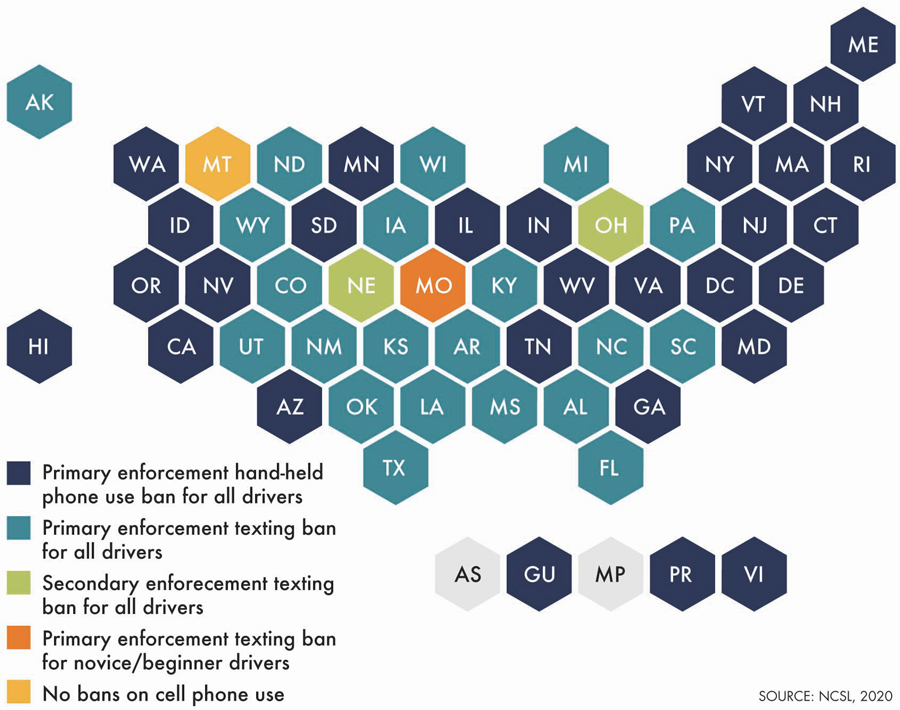People are easily distracted in a world filled with more distractions every day. In this day of modern technology, it is easy to get overwhelmed with the number of distracting devices out there, and these devices have encroached upon the driving environment. Cell phones are convenient means to communicate over long distances, but couple them with texting, email, internet, and mobile video, and they are an absolute attention grabber.
They can be coupled with hands-free Bluetooth devices that allow a driver to talk with limited interaction with the phone, and they can be useful in displaying directions when used as a GPS. However, even when using these safer methods of interaction, they divert the attention of the driver from their primary task — driving a vehicle. And cell phones are not the only distractions in a vehicle. People still eat or drink while driving, fiddle with the radio, read the paper or magazines, talk on CB radios, play with smart watches, and perform personal grooming like shaving or brushing their hair. Some vehicles even have video players in them. Drive on the road long enough and look at what the other drivers are doing. It is astounding what people will do while driving and the absurd risks they are willing to accept.
WHERE CAN I FIND MORE INFORMATION?
The National Highway Transportation and Safety Administration (NHTSA), which is part of the U.S. Department of Transportation, has created a website for distracted driving information: www.distraction.gov. It is loaded with statistics and information that can be disseminated to co-workers and teen drivers and used by employers for employee distracted-driving awareness training.
Here are some key facts and statistics from that website:
- In 2019, 3,142 people were killed, and 424,000 people were injured in motor vehicle crashes involving distracted drivers. More than 26,000 have been killed between 2012 and 2019
- In 2019, an estimated 2.1 trillion text messages were sent in the USA.
(https://www.ctia.org/news/report-2020-annual-survey-highlights) - Nine percent of all drivers 15 to 19 years old involved in fatal crashes were reported as distracted at the time of the crashes. This age group has the largest proportion of drivers who were distracted at the time of the crashes. (http://www-nrd.nhtsa.dot.gov/Pubs/812132.pdf)
- In 2019, 566 nonoccupants (pedestrians, bicyclists, and others) were killed in distraction-affected crashes. (http://www-nrd.nhtsa.dot.gov/Pubs/812132.pdf)
- The USA had over 442.5 million wireless subscribers in 2019. (https://www.ctia.org/news/report-2020-annual-survey-highlights)
- In 2019, there were an estimated 287,000 distraction-affected injury crashes (15 percent of all injury crashes). In these crashes, an estimated 294,000 drivers (8% of all drivers in injury crashes) were distracted at the time of the crash. (http://www-nrd.nhtsa.dot.gov/Pubs/812132.pdf)
- Five seconds is the average time your eyes are off the road while texting. When traveling at 55mph, that’s enough time to cover the length of a football field blindfolded. (http://mcsac.fmcsa.dot.gov/documents/DriverDistractionStudy.pdf)
- Smartphone ownership is growing. In 2019, 37.1 trillion megabytes of data were used in the USA. (https://www.ctia.org/news/report-2020-annual-survey-highlights)
- More than half (53%) of all adult cellphone owners have been on the giving or receiving end of a distracted-walking encounter. (http://www.pewresearch.org/fact-tank/2014/01/02/more-than-half-of-cell-owners-affected-by-distracted-walking/)
WHAT CAN EMPLOYERS DO TO REDUCE DISTRACTED DRIVING?
Employers are certainly not powerless to prevent distracted driving by employees while on company time or in a company vehicle. The U.S.DOT encourages employers to create a distracted driving policy. It will provide videos, posters, and sample policies to encourage better driving habits. There is a lot of hands-free technology available for use that can either be provided for employees, or you can encourage your employees to purchase it. Before purchase, however, be aware of which states allow the use of such devices. The map provides more information regarding hand-free device and texting bans or allowances.

Figure 1: State Laws Addressing Cellphone Use while Driving
HOW CAN PARENTS PREVENT DISTRACTED DRIVING?
Parents can use videos and talk with the children regarding distracted driving. Many states ban the use of cell phones for young drivers. Additionally, apps are available that parents can put on their children(s) smart phones that will disable the phone while it is in motion. A list of these apps for Android devices can be found here https://bit.ly/2T5DcV2 as an example of what’s available. A similar number are available for use on Apple devices.
Teens and young adults are prone to distractions while driving. With the many social apps available out there, they have a tendency to need to feel “connected” and may be inclined to pick up the phone when it beeps. Couple that distraction with their inexperience driving, and it can lead to tragedy, as the statistics from the U.S. DOT show.
Teenagers can also make pacts with each other to not use the phone while driving. A friend riding as a passenger can be affected just as adversely by a distracted driving accident as the driver, so they can make it their responsibility to prevent drivers from using the phone while driving.
Adults, for the most part, have less connection on social networking and don’t tend to reach for the phone each time it beeps, and their accumulated windshield time has given them the experience necessary to react better in emergency situations. However, they do have reduced reaction time, which slows as you age, and can be distracted due to other outside forces. These can include lack of sleep (i.e. new parents, stressful work, etc.) or time pressure (i.e. in a rush to get to work). So teens AND parents should take a pledge together to concentrate on driving and to avoid or mitigate those distractions that affect them the most.
HOW CAN TEACHERS PREVENT DISTRACTED DRIVING?
Schools can get involved in reducing distracted driving, too. They can run a pledge drive, encouraging students and other educators to not drive distractedly. They can use the various posters or videos available to spread the word on distracted driving. They can also encourage parents to use some of the methods mentioned above to mitigate a teen or young adults distracted driving.
HOW ELSE CAN DISTRACTED DRIVING BE PREVENTED?
Local community groups, such as churches or other youth groups (i.e. the Boy Scouts of America) can get involved in reducing distracted driving. Distraction.gov has a free downloadable campaign kit available for these groups. Additionally, voters can support local driving laws and ensure their local police departments enforce those laws.
CONCLUSION
Many things can divert a person’s attention from driving, and in this digital age, the cell phone is probably the most prevalent. Communicate with others about distracted driving and follow your state laws. Make it a point to be a better, more attentive driver, and it will be hard not to see the improvements in driving ability.
 Paul Chamberlain has been the Safety Manager for American Electrical Testing Company Inc. since 2009. He has been in the safety field since 1998, working for various companies and in various industries. He received a Bachelor of Science from Massachusetts Maritime Academy.
Paul Chamberlain has been the Safety Manager for American Electrical Testing Company Inc. since 2009. He has been in the safety field since 1998, working for various companies and in various industries. He received a Bachelor of Science from Massachusetts Maritime Academy.
